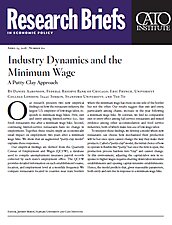Our empirical findings are derived from the Quarterly Census of Employment and Wages (QCEW), a database used to compile unemployment insurance payroll records collected by each state’s employment office. The QCEW provides detailed information on each establishment’s name, location, and employment level at a monthly frequency. We compare restaurants located in counties near state borders where the minimum wage has risen on one side of the border but not the other. Our results suggest that exit and entry, particularly among chains, increase in the year following a minimum wage hike. By contrast, we find no comparable exit or entry effect among full-service restaurants and mixed evidence among other accommodation and food service industries, both of which make less use of low-wage labor.
To interpret these findings, we develop a model where new restaurants can choose how mechanized their production will be but once open cannot change the way they make their products. Called a “putty-clay” model, the initial choice of how to operate is flexible like “putty,” but once the firm is open, the production process hardens into “clay” and cannot change. In this environment, adjusting the capital-labor mix in response to higher wages requires shutting down labor-intensive establishments and opening capital-intensive establishments. Hence, the model predicts that, given reasonable parameters, both entry and exit rise in response to a minimum wage hike.
Not only does the putty-clay model match our new empirical findings on exit and entry, but it also generates three other predictions that appear consistent with the minimum wage literature. First, the model implies that the cost of higher minimum wages is fully passed on to consumers in the form of higher prices. Second, despite the pass-through, profits and firm value among incumbent restaurants fall. Third, because continuing restaurants cannot adjust their employment levels, the putty-clay model generates a small short-run employment response.
A key implication of the model is that the short- and long-run effects of minimum wage hikes are different. In the putty-clay model, the disemployment effect of the minimum wage hike grows over time, as labor-intensive incumbent restaurants are slowly replaced with more capital-intensive entrants. Thus, the empirical assessment in the literature that the short-run disemployment effects of minimum wage hikes are small may provide an imperfect guide to the longer-run effects of minimum wage hikes. Specifically, relative to what is typically inferred from existing work, alternative minimum wage policies may have more negative employment consequences and be a less effective redistributive tool.
NOTE:
This research brief is based on Daniel Aaronson, Eric French, Isaac Sorkin, and Ted To, “Industry Dynamics and the Minimum Wage: A Putty-Clay Approach,” International Economic Review 59, no. 1 (February 2018): 51–84.
